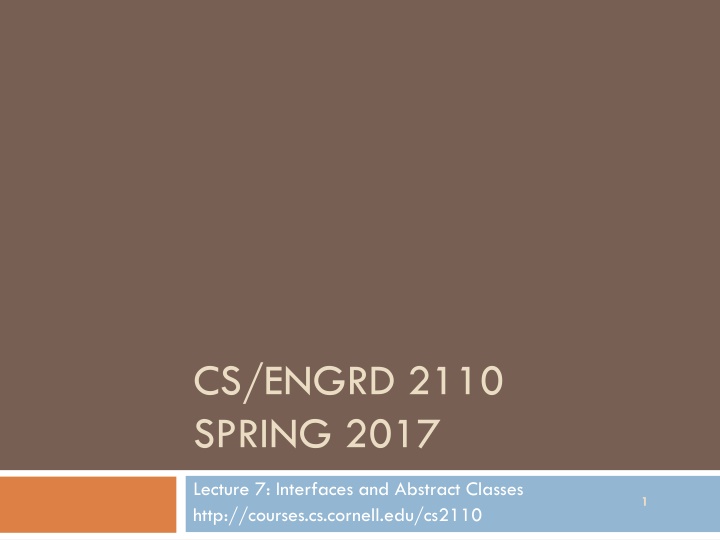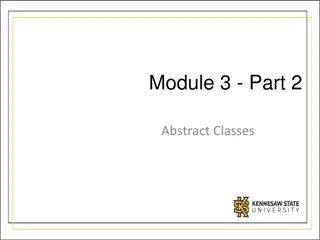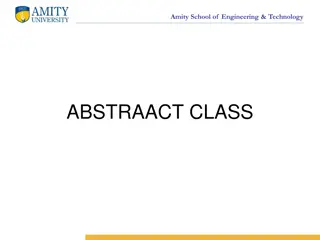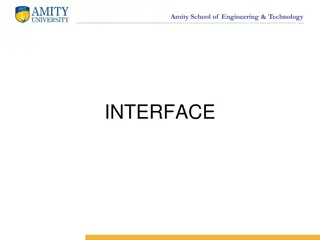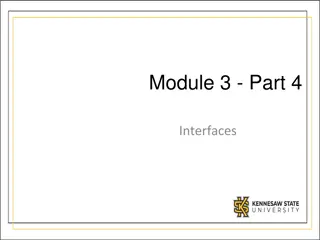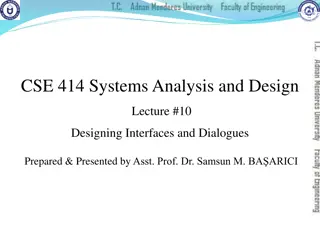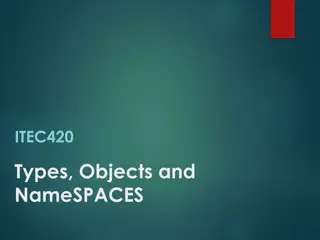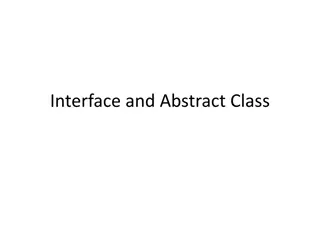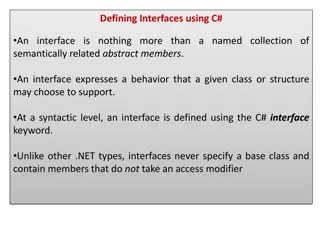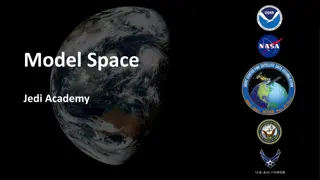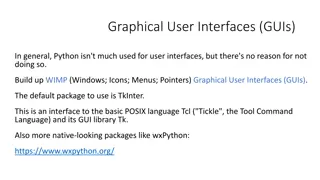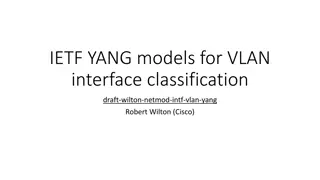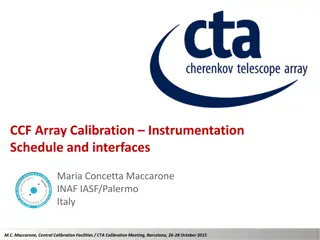Interfaces and Abstract Classes Overview
Concepts of interfaces and abstract classes in the context of geometric shapes through a series of lectures and problem-solving scenarios. Delve into the distinction between abstract classes and interfaces, handling object creation, and designing solutions for shape hierarchies. Discover strategies for calculating areas of various shapes and ensuring proper method implementations in subclasses.
Download Presentation

Please find below an Image/Link to download the presentation.
The content on the website is provided AS IS for your information and personal use only. It may not be sold, licensed, or shared on other websites without obtaining consent from the author.If you encounter any issues during the download, it is possible that the publisher has removed the file from their server.
You are allowed to download the files provided on this website for personal or commercial use, subject to the condition that they are used lawfully. All files are the property of their respective owners.
The content on the website is provided AS IS for your information and personal use only. It may not be sold, licensed, or shared on other websites without obtaining consent from the author.
E N D
Presentation Transcript
CS/ENGRD 2110 SPRING 2017 Lecture 7: Interfaces and Abstract Classes http://courses.cs.cornell.edu/cs2110 1
Announcements 2 A2 is due tomorrow night (17 February) Get started on A3 a method every other day 2
A Little Geometry! 3 (x, y) Position of a rectangle in the plane is given by its upper-left corner (x, y) Position of a circle in the plane is given by the upper-left corner of its bounding box 3
A Little Geometry! Abstract Classes class Shape contains the coordinates of a shape in the plane. Each subclass declares the fields to contain the size and function area Shape x ____ y ____ Write variables as lines instead of boxes Rectangle area() width ____ height ____ Triangle area() base____ height ____ Circle area() radius __5__ 4 4
Problem: Dont like creation of Shape objects Abstract Classes PROBLEM Since an object of Shape is not really a shape, don t want to allow creation of objects of class Shape! Shape x ____ y ____ Solution public abstract class Shape { } Rectangle area() width ____ height ____ Circle area() radius __5__ Syntactic rule: if a class C is abstract, the new-expression new C( ) cannot be used! 5 5
Attempt at writing function sumAreas Abstract Classes /** Return sum of areas of shapes in s */ public static double sumAreas(Shape[] s) { double sum= 0; for (int k= 0; k < s.length; k= k+1) sum= sum + s[k].area(); return sum; Does this work? } Problems: 1. Use instanceof to figure out which subclass s[k] is and cast down so that function area() can be called. Adding new Shape subclass requires modifying sumAreas 6 6
A Partial Solution: Abstract Classes Add method area to class Shape: public double area() { return 0; } Problem: a subclass might forget to override area(). Use this instead? Problem: a subclass might still forget to override area(). public double area() { throw new RuntimeException( area not overridden ); } 7 7
Good solution: Abstract Classes In abstract class Shape, to require all subclasses to override function area, make it abstract: public abstract class Shape { /** Return the area of this shape */ public abstract double area() ; Syntax: If a method has keyword abstract in its declaration, use a semicolon instead of a method body } 8 8
Abstract Summary Abstract Classes 1. To make it impossible to create an instance of a class C, make C abstract: Syntax: the program cannot be compiled if it contains a new-expres- sion new C( ) and C is abstract. public abstract C { } 2. In an abstract class, to require each subclass to override method m( ), make m abstract: Syntax: the program cannot be compiled if a subclass of an abstract class does not override an abstract method. public abstract int m( ) ; 9 9
Abstract class used to define a type (abstract data type) Type: set of values together with operations on them Suppose we want to define type Stack (of ints). It s operations are: isEmpty() --return true iff the stack is empty push(k) --push integer k onto the Stack pop() --pop the top stack element public abstract class Stack { public abstract boolean isEmpty(); public abstract void push(int k); public abstract int pop(); } Naturally, need specifications 10 10
public abstract class Stack { public abstract boolean isEmpty(); public abstract void push(int k); public abstract int pop(); } Example of subclasses of Stack public class ArrayStack extends Stack{ private int n; // stack elements are in private int[] b; // b[0..n-1]. b[0] is bottom Missing lots of tests for errors! Missing specs! /** Constructor: An empty stack of max size s. */ public ArrayStack(int s) {b= new int[s];} public boolean isEmpty() {return n == 0;} public void push(int v) { b[n]= v; n= n+1;} public int pop() {n= n-1; return b[n]; } } 11 11
public abstract class Stack { public abstract boolean isEmpty(); public abstract void push(int k); public abstract int pop(); } Example of subclasses of Stack public class LinkedListStack extends Stack{ private int n; // number of elements in stack private Node first; // top node on stack Missing lots of tests for errors! Missing specs! /** Constructor: An empty stack */ public LinkeListStack() {} public boolean isEmpty() {return n == 0;} public void push(int v) { prepend v to list} public int pop() { } } 12 12
Flexibility! public abstract class Stack { } public class LinkedListStack extends Stack { } public class ArrayStack extends Stack { } /** A class that needs a stack */ public class C { Stack st= new ArrayStack(20); public void m() { ptr in a variable of type Stack! Choose an array implementation, max of 20 values Store the st.push(5); Use only methods available in abstract class Stack } } 13 13
Flexibility! public abstract class Stack { } public class LinkedListStack extends Stack { } public class ArrayStack extends Stack { } /** A class that needs a stack */ public class C { Stack st= new ArrayStack(20); public void m() { st.push(5); LinkedListStack(); Want to use a linked list instead of an array? Just change the new-expression! } } 14 14
Interfaces An interface is like an abstract class all of whose components are public abstract methods. Just have a different syntax We don t tell you immediately WHY Java has this feature, this construct. First let us define the interface and see how it is used. The why will become clear as more and more examples are shown. (an interface can have a few other kinds of components, but they are limited. For now, it is easiest to introduce the interface by assuming it can have only public abstract methods and nothing else. Go with that for now!) 15
Interfaces An interface is like an abstract class all of whose components are public abstract methods. Just have a different syntax public abstract class Stack { public abstract boolean isEmpty(); public abstract void push(int k); public abstract int pop(); } Here is an abstract class. Contains only public abstract methods public interface Stack { public abstract boolean isEmpty(); public abstract void push(int k); public abstract int pop(); } Here is how we declare it as an interface 16
Interfaces public abstract class Stack { public abstract boolean isEmpty(); public abstract void push(int k); public abstract int pop(); } public interface Stack { boolean isEmpty(); void push(int k); int pop(); } Since methods have to be public and abstract, we can leave off those keywords. Extend a class class StackArray } Implement an interface class StackArray implements Stack { } extends Stack { 17
A start at understanding use of interfaces Have this class hierarchy: class Animal { } class Mammal extends Animal { ... } class Bird extends Animal { } class Human extends Mammal {. } class Dog extends Mammal { } class Parrot extends Bird { } Animal Mammal Bird Human Dog Parrot 18
A start at understanding use of interfaces Humans and Parrots can whistle. Other Animals cannot. listenTo is given as a whistling method: public void listenTo(String w) { System.out.println(w); } We need a way of indicating that classes Human and Parrot have this method listenTo Animal Mammal Bird Parrot Human Dog 19
A start at understanding use of interfaces public interface Whistle { void listenTo(String w) ; } public class Human extends Mammal implements Whistle { public void listenTo(String w) { System.out.println(w); } } Animal Whistle Mammal Bird (similarly for Parrot) Parrot Human Dog 20
Heres what an object of class Human looks like public interface Whistle { void listenTo(String w) ; } public class Human extends Mammal implements Whistle { public void listenTo(String w) { } } Usual drawing of object Draw it this way Add interface dimension Human@1 Animal Animal Mammal Whistle Mammal Human Human 21
Heres what an object of class Human looks like public interface Whistle { void listenTo(String w) ; } public class Human extends Mammal implements Whistle { public void listenTo(String w) { } } A dimension for each class that is extended and interface that is implemented Animal Mammal Whistle Human 22
Heres what an object of class Human looks like Human h= new Human(); Object ob= h; Animal a= (Animal) ob; Mammal m= h; Whistle w= h; h, ob, a, m, and w all point to the same object. The object can be (and is) cast to any partition in it: h, ob, a, m, and w. Animal Mammal Whistle Upward casts: can be implicit; inserted by Java Downward casts: must be explicit Human 23
A real use of interface: sorting Consider an array of Shapes: want to sort by increasing area Consider an array of ints: want to sort them in increasing order Consider an array of Dates: want to put in chronological order We don t want to write three different sorting procedures! The sorting procedure should be the same in all cases. What differs is how elements of the array are compared. So, write ONE sort procedure, tell it the function to be used to compare elements. To do that, we will use an interface. 24
Interface Comparable<T> Package java.lang contains this interface public interface Comparable<T> { /** = a negative integer if this object < c, = 0 if this object = c, = a positive integer if this object > c. Throw a ClassCastException if c can t be cast to the class of this object. */ int compareTo(T c); } 25
Real example: Comparable<T> We implement Comparable<T> in class Shape public abstract class Shape { /** Return the area of this shape */ public abstract double area() ; Implements Comparable<Shape> /** Return negative number, 0, or a positive number depending on whether this are is <, =, or > c s area */ public int compareTo(Shape c) { double diff= area() c.area(); return diff == 0 ? 0 : (diff < 0 ? -1 : 1); } 26
Arrays.sort has this method. /** Sort array b. Elements of b must implement interface Comparable<T>. Its method compareTo is used to determine ordering of elements of b. */ Arrays.sort(Object[] b) Shape implements Comparable, so we can write // Store an array of values in shapes Shape[] shapes= ...; ... Arrays.sort(shapes); 27
What an object of subclasses look like public abstract class Shape implements Comparable<Shape>{ } public class Circle extends Shape { } public class Rectangle extends Shape { } When sort procedure is comparing elements of a Shape array, each element is a Shape. Sort procedure views it from Comparable perspective! Comparable Comparable Object Object Shape Shape Rectangle Circle 28
Abstract Classes vs. Interfaces Abstract class represents something Shar3 common code between subclasses Interface is what something can do defines an abstract data type A contract to fulfill Software engineering purpose Similarities: Can t instantiate Must implement abstract methods Later we ll use interfaces to define abstract data types (e.g. List, Set, Stack, Queue, etc) 29 29
